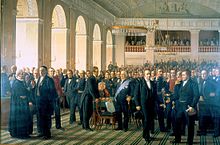- Constitution of Denmark
-
Denmark 
This article is part of the series:
Politics and government of
DenmarkConstitutionMonarchyGovernmentJudiciaryLegislatureElectionsSubdivisionsForeign policy
The Constitutional Act of Denmark (Danish: Danmarks Riges Grundlov) is the Kingdom of Denmark's constitution, or fundamental law. Originally verified in 1849, the last revision was signed on 5 June 1953[1] as "the existing law, for all to unswerving comply with, the Constitutional Act of Denmark".[2]
Contents
Idea and structure
The main principle of the Constitution was to limit the monarch’s power (§ 2). The Constitution of 1849 established a bicameral parliament, the Rigsdag, consisting of the Landsting and the Folketing. It also secured civil rights, which remain in the current constitution, such as habeas corpus (§ 71), private property rights (§ 72) and freedom of speech (§ 77).
The Constitution is based on the separation of powers into the three branches of government, the legislative, the executive and the judiciary branches, which stems from ancient Greece. The Constitution is heavily influenced by the French philosopher Montesquieu, whose separation of powers was aimed at achieving mutual monitoring of each of the branches of government. This is achieved through the Constitution’s § 3, although the division between legislative and executive power is not as sharp as in e.g. the United States.
The Act of Succession to the Danish Throne (Danish: "Tronfølgeloven") of 27 March 1953 also has status as a constitutional law, as it is directly referred to in Article 2 of the Constitutional Act. Therefore, amendments to the Act of Succession require adherence to the constitutional amendment procedure as provided for in Article 88 of the Danish Constitution Act. An amendment to abolish male preference to the throne (bill no. 1, Folketing session of 2005-06) was passed by a referendum in 2009.
Certain particular customs which are not explicitly referred to in the Constitutional Act itself, but that have been recognised as carrying constitutional legal weight (such as the right of the Finance Committee to authorise public expenditure outside of the national budget), also form part of Danish Constitutional law.
History
 The National Constitutional Assembly (painting by Constantin Hansen) (Frederiksborg Castle, Hillerød)
The National Constitutional Assembly (painting by Constantin Hansen) (Frederiksborg Castle, Hillerød)
The original constitution of Denmark was signed on June 5, 1849 by King Frederick VII. The event marked Denmark’s transition to constitutional monarchy, putting an end to the absolute monarchy which had been introduced in Denmark in 1660. The Constitution has been rewritten 4 times since 1849.
The first constitution of Denmark was Lex Regia (Royal Law, Danish: Kongeloven) of 1665, establishing absolute power for King Frederick III of Denmark, and replacing the old feudal system. This is Europe's only formal absolutist constitution[3]. Absolute power was passed along with a succession of Danish monarchs until Frederick VII who agreed to sign the new constitution into law on 5 June 1849, which has since been a Danish national holiday.
Frederick VII's father and immediate predecessor, Christian VIII, ruled Denmark from 1839 to 1848, had earlier been king of Norway until political turmoil of 1814 forced him to abdicate after a constitutional convention. Those who supported similar constitutional reforms in Denmark were disappointed with his refusal to acknowledge any limitations to his inherited absolute power, and had to wait for his successor to put through the reforms.[4]
Ditlev Gothard Monrad, who became Secretary in 1848 drafted the first copy of the Constitution, based on a collection of the constitutions of the time, sketching out 80 paragraphs, whose basic principles and structure resembles the current constitution. The language of the draft was since revised by Secretary Orla Lehmann among others, and since treated in the Constitutional Assembly of 1848 (Danish: Grundlovsudvalget af 1848). Sources of inspiration for the Constitution include the Constitution of Norway of 1814 and the Constitution of Belgium. The constitution’s civil rights are based on the Constitution of the United States of 1787, especially the Bill of Rights.
The government’s draft was laid before the Constitutional Assembly of the Realm (Danish: Den Grundlovgivende Rigsforsamling), part of which had been elected on October 5, 1848, the remainder having been appointed by the King. The 152 members were mostly interested in the political aspects, the laws governing elections and the composition of the two chambers of Parliament. The Constitution was adopted during a period of strong national unity, namely the First Schleswig War, which lasted from 1848-1851.
Changes
The Danish constitution has been rewritten four times since 1849, namely in 1866, 1915, 1920 and in 1953 to the current version. According to § 88 of the new Constitution, changing the Constitution requires a majority in two consecutive Parliaments, i.e. before and after a general election. In addition, the Constitution must pass a popular vote, with the additional demand that at least 40 % of the voting population voting yes.
Four changes over the course of over 150 years is not much relative to other countries. This is partly because the Constitution only sets out the basic principles, with more detailed regulation left over to the legislative branch of government, currently the Danish parliament Folketinget. The wearisome amendment process also plays a part.
The 4 changes can be summed up as follows:
- In 1866 the defeat in the Second Schleswig War, and the loss of Schleswig-Holstein led to tightened election rules for the Upper Chamber, which paralyzed legislative work, leading to provisional laws.
Background: The conservative party “Højre” (Right) pressed for a new constitution, giving the upper chamber of parliament more power, making it more exclusive and switching power to the conservatives from the original long standing dominance of the National liberals, who lost influence and was later disbanded. This long period of dominance of the Højre party under the leadership of Jacob Brønnum Scavenius Estrup with the backing of the king Christian IX of Denmark was named the provisorietid (provisional period) because the government was based on provisional laws instead of parliamentary decisions. This also gave rise to a conflict with the Liberals (farm owners) at that time and now known as “Venstre” (Left). This constitutional battle concluded in 1901 with the so called systemskifte (change of system) with the liberals as victors. At this point the king and Højre finally accepted parliamentarism as the ruling principle of Danish political life. This principle was not codified until the 1953 constitution.
- In 1915 the tightening from 1866 was reversed, and women were given the right to vote. Also, the required number of votes in favor of a change of the Constitution was increased to 45 % of the electorate. This meant that Prime Minister Stauning’s attempt to change the Constitution in 1939 failed[5].
- In 1920 a new referendum was held to change the Constitution again, allowing for the reunification of Denmark following the defeat of Germany in World War I. This followed a referendum held in the former Danish territories of Schleswig-Holstein regarding how the new border should be placed. This resulted in upper Schleswig becoming Danish, today known as South Jutland, and the rest remained German.
- In 1953, the fourth constitution abolished the Upper Chamber (the Landsting), giving Denmark a unicameral parliament. The other main purpose was to enable women to inherit the throne (see Succession), although the change still favored boys over girls (this was changed by a referendum in 2009 so the first-born inherits the throne regardless of sex). Finally, the required number of votes in favor of a change of the Constitution was decreased to the current value of 40 % of the electorate.
Additional details
Human rights
The Constitution of Denmark outlines certain human rights in §§ 71-80. Several of these are only of limited scope, and thus serve as a sort of lower bar. The European Convention on Human Rights was introduced in Denmark by law on April 29, 1992 and supplements the mentioned paragraphs.
Symbolic status of the King
When reading the Danish Constitution, it is important to bear in mind that the King is meant to be read as the government because of the regent’s symbolic status. This is a consequence of §§ 12 and 13, by which the King executes his power through his ministers, who are responsible for governing. An implication hereof is that the acting monarch cannot act on his/her own in disregard of the ministers, and so the Danish monarchs do not interfere in politics[6].
Religion
§ 4 establishes that the Danish Lutheran Church is Denmark’s official church, and as such is supported by the state. Freedom of religion is granted in § 67 and official discrimination based on faith is forbidden in § 70.
National sovereignty
§ 20 of the current constitution establishes that specified parts of national sovereignty can be delegated to international authorities, if the Parliament and/or the electorate vote for it. This section has been debated heavily in connection with Denmark’s membership of the European Union, as critics hold that changing governments have violated the Constitution by surrendering too much power to the EU.
In 1996, Prime Minister Poul Nyrup Rasmussen was sued by 12 EU-skeptics for violating this section. The Danish Supreme Court (Danish: Højesteret) acquitted Rasmussen (and thereby earlier governments dating back to 1972) but reaffirmed that there are limits to how much sovereignty can be surrendered. However, the Danish EU-membership does not violate the Constitution.
See also
References
- ^ "CIA World Factbook: Denmark: Government". https://www.cia.gov/library/publications/the-world-factbook/geos/da.html. Retrieved 8 July 2009.
- ^ Constitutional Act of Denmark, 5 June 1953 (WikiSource)
- ^ Folketinget
- ^ [1]
- ^ Søren Mørch: 24 statsministre. ISBN 87-02-00361-9.
- ^ Grundloven, Mikael Witte 1997 ISBN 87-7724-672-1
External links
- Details on the Constitution from the Danish Ministry of Foreign Affairs
- (Danish) history of the Danish Constitution (Folketinget)
- [2] - (Danish) report from the Parliament's conference about the need for revising the Constitution
States with limited
recognition- Abkhazia
- Kosovo
- Nagorno-Karabakh
- Northern Cyprus
- South Ossetia
- Transnistria
Dependencies
and other territoriesOther entities - European Union
- Sovereign Military Order of Malta
 Denmark topics
Denmark topicsHistory Geography Government
& PoliticsConstitution · Prime Minister (List) · Folketing · Council of State · Courts · Foreign relations · Political parties (Social Democrats · Social Liberal Party · Conservative People's Party · Socialist People's Party · Danish People's Party · Venstre · Red-Green Alliance) · Elections · Law · MilitaryMonarchy List · Family tree · Succession · Crown Regalia · Order of the Elephant · Order of the Dannebrog · Royal residencesEconomy National Bank · Stock Exchange · Krone · Taxation · Companies · Communications · Transport · TourismSociety Culture Language · Cinema · Cuisine · Literature · Modern Breakthrough · Music (List) · Art (List) · Architecture · Photography · Public holidays · Sport · Jante Law · Scout CouncilSymbols  Category ·
Category ·  Portal ·
Portal ·  WikiProjectCategories:
WikiProjectCategories:- 1849 in law
- Constitutions by country
- Government of Denmark
- History of Denmark
- Politics of Denmark
- Danish law
- 1849 in Denmark
Wikimedia Foundation. 2010.


